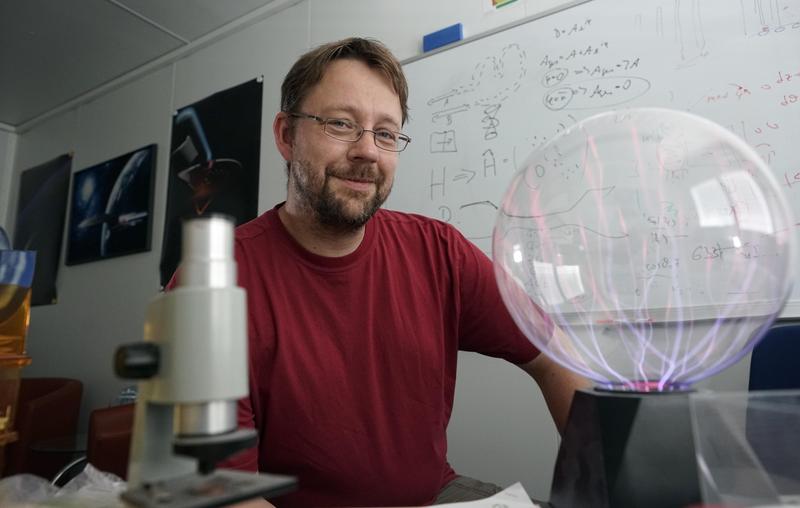

Alexander Szameit and his team developed a photonic set-up that can simulate non-physical processes in a laboratory.
Photo: Jan-Peter Kasper/FSU
March 1938: The Italian elementary particle physicist Ettore Majorana boarded a post ship in Naples, heading for Palermo. But he either never arrives there – or he leaves the city straight away – ever since that day there has been no trace of the exceptional scientist and until today his mysterious disappearance remains unresolved.
Since then, Majorana, a pupil of the Nobel Prize winner Enrico Fermi, has more or less been forgotten. What the scientific world does remember though is a theory about nuclear forces, which he developed, and a very particular elementary particle.
“This particle named after Majorana, the so-called Majoranon, has some amazing characteristics“, the physicist Professor Dr. Alexander Szameit of the Friedrich Schiller University Jena says. “Characteristics which are not supposed to be existent in our real world.“
Majorana particles are, for instance, their own antiparticles: Internally they combine completely opposing characteristics – like opposing charges and spins. If they were to exist, they would extinguish themselves immediately. “Therefore, Majoranons are of an entirely theoretical nature and cannot be measured in experiments.“
Together with colleagues from Austria, India, and Singapore, Alexander Szameit and his team succeeded in realizing the impossible. In the new edition of the science magazine 'Optica' they explain their approach: Szameit and his team developed a photonic set-up that consists of complex waveguide circuits engraved in a glass chip, which enables them to simulate charged Majorana particles and, thus, allows to conduct physical experiments.
“At the same time we send two rays of light through parallel running waveguide lattices, which show the opposing characteristics separately,“ explains Dr. Robert Keil, the first author of the study. After evolution through the lattices, the two waves interfere and form an optical Majoranon, which can be measured as a light distribution. Thus, the scientists create an image that catches this effect like a photograph – in this case the state of a Majoranon at a defined moment in time. “With the help of many of such single images the particles can be observed like in a film and their behaviour can be analyzed,“ says Keil.
This model allows the Jena scientists to enter completely unknown scientific territory, as Alexander Szameit stresses. “Now, it is possible for us to gain access to phenomena that so far only have been described in exotic theories.“ With the help of this system, one can conduct experiments in which conservation of charge – one of the pillars of modern physics – can easily be suspended. “Our results show that one can simulate non-physical processes in a laboratory and, thus, can make practical use of exotic characteristics of particles that are impossible to observe in nature.“ Szameit foresees one particular promising application of simulated Majoranons in a new generation of quantum computers. “With this approach, much higher computing capacities than are possible at the moment can be achieved.“
Original Publication:
Keil R. et al. Optical simulation of charge conservation violation and Majorana dynamics. Optica, Vol. 2, Issue 5, pp. 454-459 (2015), doi: 10.1364/OPTICA.2.000454
Contact:
Prof. Dr. Alexander Szameit
Institute of Applied Physics
Friedrich Schiller University Jena
Albert-Einstein-Strasse 15, 07745 Jena
Germany
Phone: ++49 3641 947985
Email: alexander.szameit[at]uni-jena.de












